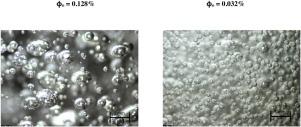Chemical Engineering Research and Design ( IF 3.7 ) Pub Date : 2021-08-14 , DOI: 10.1016/j.cherd.2021.08.009 Keon Bae 1 , Jun Young Kim 2 , Kang Seok Go 3, 4 , Nam Sun Nho 3, 4 , DongJae Kim 5 , Jong Wook Bae 1 , DongHyun Lee 1

|
The effect of distributor geometry on bubble characteristics in an air–kerosene system of a pressurized bubble column was evaluated. The experiment was carried out using a cylindrical stainless column with an inner diameter of 0.097 m and a height of 1.8 m under a system pressure up to 3.5 MPa. The gas holdup was calculated under pressure taps from 0.05 m to 0.85 m above the distributor along axial direction of the column. Bubble size was measured with an optical probe installed 0.5 m above the distributor. Perforated plates with four different hole sizes including 0.8 mm (20 each), 1 mm (12 each), 2 mm (3 each), and 3.46 mm (1 each) fixed with the same opening fraction (ϕo = 0.128%) were evaluated. Different opening fractions at 0.223% (21 holes), 0.128% (12 holes), 0.074% (7 holes), and 0.032% (3 holes) were also tested with a constant hole size (1 mm). The effect of the distributor geometry on bubble characteristics was determined with seven different types of perforated plates. The number of microbubbles was increased with decreasing opening fraction of the distributor. Based on dynamic gas disengagement (DGD) analysis, microbubbles were rarely generated in all distributors under conditions of Psys = 0.1 MPa at Ug = 12.3 mm/s. However, a significant number of microbubbles were generated at ϕo = 0.032% despite a low flow rate at Psys = 3.5 MPa. Microbubble ratio varied from 36% to 40% at ϕo = 0.128 %, while this ratio varied from 38% to 73% at ϕo = 0.032%.
中文翻译:

分配器类型对加压泡罩塔内微泡分散的影响
评估了分配器几何形状对加压气泡塔的空气-煤油系统中气泡特性的影响。实验采用内径为0.097 m,高度为1.8 m的圆柱形不锈钢柱在高达3.5 MPa的系统压力下进行。气体保持率是在沿塔轴向分布器上方 0.05 m 至 0.85 m 的测压口下计算的。使用安装在分配器上方 0.5 m 处的光学探头测量气泡大小。具有四种不同孔径的穿孔板,包括 0.8 毫米(每个 20 个)、1 毫米(每个 12 个)、2 毫米(每个 3 个)和 3.46 毫米(每个 1 个)固定有相同的开口率 (φ o= 0.128%) 进行评估。还在恒定孔尺寸 (1 mm) 下测试了 0.223%(21 孔)、0.128%(12 孔)、0.074%(7 孔)和 0.032%(3 孔)的不同开口率。分布器几何形状对气泡特性的影响由七种不同类型的穿孔板确定。微气泡的数量随着分布器开口率的降低而增加。基于动态气体分离 (DGD) 分析,在 P sys = 0.1 MPa 和 U g = 12.3 mm/s 的条件下,所有分配器中很少产生微气泡。然而,尽管在 P sys = 3.5 MPa 时流速较低,但在 φ o = 0.032% 时产生了大量微气泡。在 ϕ 时,微泡比率从 36% 到 40% 不等o = 0.128 %,而该比率在 ϕ o = 0.032% 时从 38% 到 73%不等。











































 京公网安备 11010802027423号
京公网安备 11010802027423号